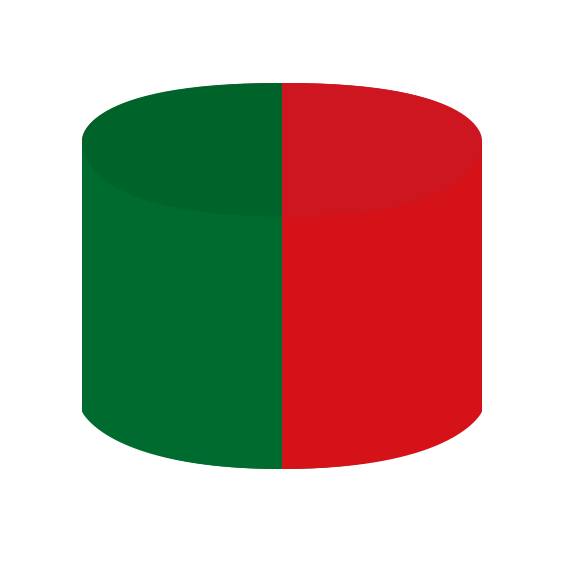A
Advertising magnets
For individual slogan on the car, we recommend the isotropic magnetic film. You can put and replace individually printed slogans on the car, and remove them without residue.
Anisotropic magnets
In the production process, anisotropic magnets receive a preferred direction with the help of an external magnetic field. They can be magnetised in a specified direction during the later magnetisations. Anisotropic magnets thus exhibit a high holding force.
Attractive or repulsive force
The force that magnets exert on metallic or other magnetic materials. If the opposite poles meet each other, the attractive force is noticeable. On the other hand, the repulsive force acts when the same poles meet each other.
C
Coating
Magnets made of neodymium must be coated to be used. The coating can be in the form of nickel, chrome, zinc, gold, copper or coloured paint.
Magnet in crafting
Are especially suited for crafting
The magnetic tape is especially popular in the field of hobby due to the simple handling. The tape can be cut with ordinary scissors or even stamped. Simple and effective figures and shapes can be created with spherical magnets. Self-adhesive disc magnets are suitable for crafting pin board magnets, whiteboard magnets, invitation carts and many other things.
D
Dispatch
We dispatch a piece of our magnets with a partitioning disc. In order to ensure a smooth dispatch, the magnets are wrapped in bubble wrap and/or foam foil to lessen the outward magnetic force.
Disposal
Small quantities of magnets can be disposed through the household garbage. For the conservation of resources, we shall be happy if you send us the scrapped magnets made of neodymium, so that we can recycle them.
E
Electrical charge
The movement of electrical charges generates a magnetic field.
Electromagnet
Electromagnets consist of a coil in which a magnetic field arises when electricity flows through the coil.
F
Field lines
These show the direction and strength of the magnetic forces. Field lines emerge from the north pole and run to the south pole.
Ferrite
Ferrite is a mixture of various iron oxides, comprising sintered magnetic metal oxides. The most important raw materials are iron oxide, barium carbonate and strontium carbonate.
G
Gauß
Gauß is a unit of measurement, to specify the strength of a magnetic field.
Glass magnets
Individual glass magnets can be very easily manufactured from glass nuggets, a disc magnet made of neodymium, an image and transparent sticker. Print a motif in the size of the glass nugget. Stick the glass nugget on the motif and then the motif on the magnet.
H
Holding force
The holding force indicates the weight a magnet can hold. Please note that this value is a reference value, which is attained under optimal conditions. The actual holding force of a magnet is dependent on the following properties:
- Distance between magnet and object it attracts
- Direction of the holding force: it works optimally, vertical to the object it attracts
- Composition (material, surface and thickness) of the holding force
I
Interaction
Magnets can attract or repel each other.
Isotropic magnets
Isotropic magnets can be magnetised in all directions. They do not show a preferred direction like the anisotropic magnets and therefore have a weak holding force.
M
Magnetic field
Magnetic fields result from magnetic materials, electric currents that give rise to magnetism, or time related changes of an electric field.Magnetisation
The magnetisation determines the position of north and south pole. Magnets receive their magnetisation in the manufacturing process. There is an axial and a diametrical magnetisation direction. 95 percent of magnets are manufactured by axial magnetisation.
- axial magnetisation = magnetisation across the height

- diametrical magnetisation = magnetisation across the diameter

Magnet shapes
We offer ferrite and neodymium magnets in disc and rectangular block shape. Apart from that, you will find magnets made of neodymium even in the following shapes in our MagnetiQ online shop:
- Cube
- Ring
- Cone
- Rod
- Sphere
Would you like another format? We will be glad to individually consult you on the telephone number +49 931 404 16 240 and offer you your desired magnets as custom made product.
Magnet system
A magnet attached to metal and/or plastic. You will find magnet systems in the categories Pot magnets as well as Office and School in our online shop.
N
NdFeB
... is a material and consists of neodymium, iron, boron. It is used for the manufacture of magnets.
Neodymium
... is a chemical element and belongs to the rare earth elements.
North pole
North pole and south pole are two different poles of a magnet. Field lines emerge from the north pole and run to the south pole. Like poles, for example, north pole against north pole repulse each other.
P
Permanent magnets
A permanent magnet has and retains its magnetic field, without the feed of electromagnets or an electric flow of current. The first artificially manufactured permanent magnet was made around 1750 by John Canton.
Preferred direction
The orientation of the molecular magnets in a certain direction.
Price-Performance ratio
Our years of experience and large storage capacities allow us to offer an optimal price-performance ratio for all magnets.
R
Rare earth elements
Rare earth elements (REE) are 17 chemical elements in the periodic table. Neodymium belongs to the light rare earth elements.
S
Self-adhesive magnets
Apart from the adhesive magnets, MagnetiQ also offers magnets with self-adhesive feature. In this, the magnet is furnished with a sticking point with an open tab on one side. Normally the 3M 467, 3M 468, and 3M 4920 stickers (pure acrylate, 0.4 mm; transparent) are used for this.
Sintering
Sintering is a procedure in the manufacture of magnets. The procedure goes through various steps. Simply put, sintering is a type of “caking” different materials. You can learn more about it in our elaborate manufacturing process (Link to manufacturing site) of magnets from neodymium.
South pole
South pole and north pole are two different poles of a magnet. The field lines emerge from the north pole and run to the south pole. Like poles, for example, south pole against south pole repulse each other.
Super magnet
Based on their strong holding force, magnets made of neodymium are also known as super magnets.
T
Tolerance
During the sintering procedure, magnets can shrink, from which arises the tolerances. The tolerance range in a neodymium magnet is +/- 0.1 mm.
W
Working temperature
The maximum working temperature for neodymium magnets is approx. 60°C or 150°C according to the particular quality of the magnet. Ferrite magnets on the other hand have a heat resistance of MINUS 40°C to 250°C. The holding force reduces if magnets are used beyond their working temperature. You will find notes on maximum working temperature for every magnet in our online ship MagnetiQ.
 Deutsch
Deutsch  English
English  Nederlands
Nederlands  Français
Français  Español
Español  Italiano
Italiano 